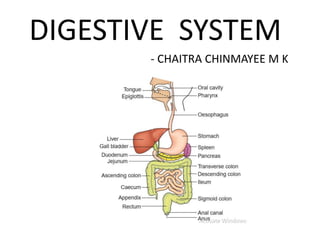
Digestive system
- 1. DIGESTIVE SYSTEM - CHAITRA CHINMAYEE M K
- 2. Functions of Digestive System:- •Digestion of food: Complex food substances are broken down into simpler forms for absorption for the energy requirements of the body • Excretory function: The undigested food along with harmful substances is excreted out of the body • Immunity: Various digestive juices have anti-bacterial secretions to play a role in the body’s immunity
- 3. The Gastro-Intestinal Tract . GI tract is a continuous tube about 10m long extending from the mouth to the anus and other accessory digestive glands. . It consists of the mouth, oral cavity, esophagus, stomach, small intestine, large intestine and anus. .Accessory structures include the teeth, tongue, salivary glands, liver, gallbladder and pancreas
- 4. Mouth & Oral Cavity • It contains teeth, tongue and salivary glands. •Food is broken down by mechanical digestion, by the teeth by chewing. • Food particles are mixed with saliva secreted by salivary glands, and broken into softer small particles for easier passage into the esophagus. • The tongue helps in tasting the food, chewing and swallowing the food.
- 5. Salivary Glands • There are 3 pairs of salivary glands called parotid, submandibular, and sublingual gland which secrete saliva into the oral cavity. •Saliva helps moisten the food during chewing, partially digest starch and help cleanse the teeth. • Saliva consists of 99.5% water, the remaining 0.5% is dissolved substances enzymes, hormones, bicarbonate ions and many other electrolytes.
- 6. Esophagus • It is a long muscular tube about 25cm long. • It conducts partially digested food from the oral cavity to the stomach. • The movement of esophagus is called Peristalisis • Peristalisis is a wave like movement of the muscle to push the food through the tube.
- 7. Stomach • The stomach is a J shaped muscular bag • It’s capacity in an average adult is 1200-1500 mL •The main function of the stomach is digestion of complex food substances like carbohydrates, fats and proteins. • The stomach stores the food for about 4-5 hours for proper digestion of its contents.
- 8. The Gastric Juice The stomach secretes gastric juice which contains: i. Mucus - it protects the wall of the stomach from highly acidic gastric juice and lubricates the food particles. ii. Pepsinogen – it is a proenzyme for protein digestion. iii. Hydrochloric Acid – it provides acidic medium for the enzymes to act and converts inactive pepsinogen into pepsin which helps in protein digestion. iv. Renin(in infants) – helps in digestion of milk proteins v. Lipases - in small quantities for partial digestion of fat
- 9. Liver and Gall Bladder • Liver is the largest gland in our body, an accessory digestive gland. • It secretes bile juice, which is stored and concentrated in the gall bladder • The bile is poured into the small intestine along with the secretions of the pancreas.
- 10. The Bile Juice • The bile juice helps in metabolism and absorption of fats and fat soluble vitamins. • It contains bile salts, bile pigments, cholesterol which helps in digestion of fats.
- 11. Pancreas • It is also an accessory digestive gland. • It secretes pancreatic juice which has a major role in digestion of carbohydrates, fats and proteins. • It is poured into the small intestine along with bile juice.
- 12. The Pancreatic Juice • It is secreted by the pancreas • It contains: i. Trypsinogen ii. Chymotrypsinogen iii. Procarboxypeptidase iv. Amylase – converts Polysaccharides into Disaccharides(Carbohydrate digestion) v. Lipase – converts Fats into Di and Monoglycerides vi. Nucleases – converts Nucleic acid into Nucleotides and nucleosides Converts Protein, peptones into dipeptides
- 13. The Small Intestine • It is a muscular tube about 6m long. • It is made up of 3 parts: i. Duodenum – 25cm ii. Jejunum – 2.5m iii. Ileum – 3.5m • The complete digestion of food particles takes place in the small intestine • It not only helps in digestion but also in absorption of the digested food particles.
- 14. The Intestinal Juice • It is secreted by the intestinal cells • It contains: i. Disaccharidases – Disaccharides to monosaccharides(Carbohydrate digestion) ii. Dipeptidases – Dipeptides to amino acids(Protein digestion) iii. Lipases – Di and monoglycerides into fatty acids and glycerol(Fat digestion) iv. Nucleosidases – Nucleosides into sugars and nitrogen bases v. Enterokinase – It activates trypsinogen, a pancreatic enzyme
- 15. Large Intestine • It is about 1.5m long • It is divided into: i. Ceacum and Appendix ii. Colon – ascending, transverse, descending and sigmoid iii. Rectum iv. Anal canal • Its major role in digestion is absorption of water and excretion of undigested food
- 16. Absorption of Digested food • It is the process by which the end products of digestion are absorbed into the blood. • The end products of digestion like glucose, amino acids, fatty acids and certain electrolytes like sodium, chloride, bicarbonate, along with water is absorbed and the rest is excreted as faeces through the anus.
- 17. Disorders of Digestive System • The most common infections are bacterial and viral infections like that caused by tape worm, round worm, hook worm, etc. • Jaundice: The infection of the liver causes the deposition of bile pigments, and causes the yellowing of skin and eyes • Vomiting: The throwing of stomach contents back through the mouth, due to over eating/contamination of food/other infections of stomach
- 18. Disorders of Digestive System(cont’d) •Constipation: Irregular excretion of faeces and its retention in the large intestine. • Indigestion: The food is not properly digested leading to a feeling of fullness. This is due to over-eating/anxiety/food poisoning. •Diarrhoea: The abnormal frequency of increased liquidity of faeces